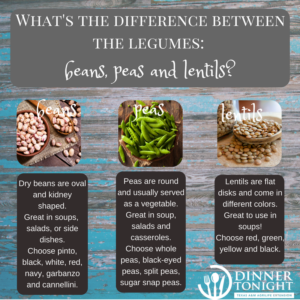Legumes…as fun to say as they are to eat! Beans, peas, and lentils are all part of a bigger group of foods called legumes! These hearty foods are a great addition to recipes.

Nutrition Highlights of Legumes
-
High in protein & plant power. Legumes like lentils, chickpeas, peas, and beans provide 9–18 g protein per cooked cup.
-
Fiber champion. With ~15 g fiber per cup (e.g. lentils) — more than half the daily recommendation,they support gut health, lower cholesterol, and maintain healthy blood sugar.
-
Packed with micronutrients. Excellent sources of folate, iron, potassium, magnesium, zinc, manganese, B-vitamins, vital for energy, immunity, and cardiovascular health .
-
Chronic disease support. Regular consumption is linked to reduced risk of heart disease, type 2 diabetes, colorectal and prostate cancers; supports weight management and blood pressure control.
Adults are advised to aim for at least ½ cup daily—or 1.5 cups per week as a minimum.
Cooking Tips & Techniques
-
Sorting & rinsing: Always remove debris, small stones, shriveled legumes and rinse under cold water.
-
Soaking dry beans:
-
Overnight soak: 12–24 h with water changed once to reduce gas and even cooking
-
Quick soak: Boil briefly, then rest 1 h before cooking.
- For a full breakdown and more details, visit our webpage on cooking with dry beans.
-
Note: Lentils and split peas don’t require soaking.
-
-
Cooking dried legumes:
-
Bring to a vigorous boil, then simmer covered until tender. Cooking time: lentils 15–20 min; split peas 35–40 min; beans/chickpeas 1–2 h—older beans need more time.
-
Skim foam and add salt/herbs toward end to boost flavor. Store beans in their cooking liquid in fridge (up to 1 week) or freezer (months).
-
-
Using canned legumes:
-
Always drain and rinse to reduce sodium.
-
Canned beans are ready to eat; simply toss into salads, soups or dips.
-
Blend into hummus or bean soups, toss into tacos, stews, salads, or form lentil patties as meat alternatives.
Beans and lentils are cost effective ways to meet your nutritional goals! Try adding or swapping out beans or lentils for your animal protein 2-3 times a week to increase your fiber, support heart health, and a healthier gut microbiome.
Sources:
-
USDA FoodData Central. Nutrient profiles for cooked lentils, black beans, chickpeas, and split peas.
https://fdc.nal.usda.gov -
Academy of Nutrition and Dietetics. “Beans: Nutrition, Preparation, and Tips.”
https://www.eatright.org -
American Heart Association. “The Benefits of Beans and Legumes.”
https://www.heart.org -
MedlinePlus (National Library of Medicine). “Dietary Fiber.”
https://medlineplus.gov/ency/patientinstructions/000727.htm -
Harvard T.H. Chan School of Public Health. “The Nutrition Source: Legumes.”
https://www.hsph.harvard.edu/nutritionsource/legumes/ -
North Dakota State University Extension. “Pocket Guide to Preparing Pulse Foods.”
https://www.ndsu.edu/agriculture/extension/publications/pocket-guide-preparing-pulse-foods -
UnlockFood.ca (Dietitians of Canada). “Cooking with Legumes.”
https://www.unlockfood.ca/en/Articles/Cooking-Food-Preparation/Cooking-with-Legumes.aspx -
UMaine Cooperative Extension. “Vegetables and Fruits for Health: Legumes.”
https://extension.umaine.edu/publications/4183e/ -
USDA SNAP-Ed. “Beans and Peas.”
https://snaped.fns.usda.gov/nutrition-education/ingredient-corner/beans-and-peas -
U.S. Food & Drug Administration (FDA). “Food Safety for Beans and Legumes.”
https://www.fda.gov -
Food Safety Authority of Ireland (FSAI). “Advice on Eating Legumes.”
https://www.fsai.ie/consumer-advice/food-safety-and-hygiene/advice-on-eating-legumes -
Centers for Disease Control and Prevention (CDC). “Food Safety: Cooking with Dry Beans.”
https://www.cdc.gov/foodsafety -
Utah State University Extension. “Cooking Dry Beans.”
https://extension.usu.edu/nutrition/recipes-and-tips/beans


 Cookies are little bites of happiness that bring the family together and are a favorite holiday treat! Keep the cookie making safe at your household with these simple food safety tips:
Cookies are little bites of happiness that bring the family together and are a favorite holiday treat! Keep the cookie making safe at your household with these simple food safety tips:



